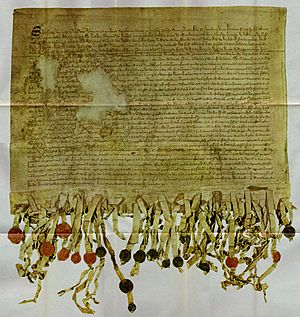Declaration of Arbroath facts for kids
The Declaration of Arbroath is a very important letter from Scotland. It was written in 1320 and sent to Pope John XXII. This letter officially declared that Scotland was an independent country. It also stated Scotland's right to defend itself with military action if it was attacked unfairly. Many important Scottish leaders, including eight earls and thirty-one barons, signed the letter in Arbroath.
Contents
Scotland's Fight for Freedom
When King Alexander III of Scotland died in 1286, his only heir was his young granddaughter, Margaret, Maid of Norway. King Edward I of England wanted his son, Edward II of England, to marry Margaret and share the Scottish crown. However, Margaret died in 1290 while traveling from Norway to Scotland.
This led to a time when Scotland had no king, called the First Interregnum (1290–1292). Edward I of England stepped in to choose the next Scottish king. He picked John of Scotland. But Edward treated King John poorly. When King John tried to gain more freedom, Edward put him in prison. In 1296, Edward invaded Scotland to take control.
Scotland remained without a king until 1306. That's when Robert the Bruce declared himself King of Scotland, challenging Edward I. Before this, Robert the Bruce had a conflict with John Comyn. Comyn died, and Robert the Bruce was crowned king just three weeks later. Because of the conflict with Comyn, the Pope removed Robert the Bruce from the church (excommunicated him).
During the wars that followed, the Scots won a major victory at the Battle of Bannockburn in 1314. In 1317, the Pope asked for a two-year truce, but Scotland did not agree. Because Scotland did not listen, the Pope excommunicated all of Scotland.
What the Declaration Said
The Declaration of Arbroath was part of a bigger plan. It aimed to show the Pope and other leaders that Scotland was an independent kingdom. It wanted to prove Scotland had the right to rule itself. The English king, Edward I, had previously written to the Pope, claiming his right to rule Scotland. The Pope, for his part, refused to accept Robert the Bruce as the true King of Scotland.
The Declaration of Arbroath was dated April 1320. It was a letter to Pope John XXII, who was in Avignon at the time. Fifty important Scottish men signed the document with their official seals. There were 39 names listed, including eight Scottish earls and thirty-one barons. Eleven more names and seals were added on strips at the bottom of the letter. Many believe that Bernard Linton, Chancellor of Scotland and Abbot of Arbroath wrote the letter. It was written at the monastery of Arbroath in Scotland.
The letter started by reminding the Pope that Saint Andrew had converted Scotland to Christianity. It said that Scotland had lived peacefully under the church's protection. But then King Edward I of England pretended to be their friend. He then invaded their country when it had no king. The letter then described the difficulties the Scots faced under English rule.
Showing their strong determination, the letter famously stated:
...for so long as there shall be but one hundred of us remain alive we will never give consent to subject ourselves to the domination of the English. For it is not glory, it is not riches, neither is it honour, but it is freedom alone that we fight and contend for, which no honest man will lose but with his life.
What Happened Next
The Pope was impressed by the Declaration. He was also pleased by the Scottish barons' promise to support the Pope's crusade. He encouraged Edward II to make peace with the Scots. The Pope sent two representatives to Scotland. The French king also wanted peace between England and Scotland, so he sent two representatives as well.
Peace talks continued until 1321. However, the English still did not recognize Scotland's independence.
The English convinced the Pope that the Scots were to blame for the lack of progress. The Pope then made six rulings against the Scots. He stated that anyone invading England would be excommunicated. He also re-issued the excommunication against Robert the Bruce.
Finally, in October 1328, Scotland and England agreed to a peace treaty. Edward III gave up all claims to rule Scotland. The ban on Scotland and the excommunication of its king were finally lifted. The treaty also arranged for Robert the Bruce's son, David II of Scotland, to marry Edward III's sister. The wedding took place on July 12, 1328. David II was four years old, and Joan of the Tower was six. They married at the church in Berwick, Scotland.
In 1998, the United States Congress passed a resolution. It stated that the US Declaration of Independence was inspired by the Declaration of Arbroath. It also declared April 6th as National Tartan Day. This day commemorates the famous Scottish document.
Related pages
- Declaration of Independence
- List of signatories of the Declaration of Arbroath
See also
 In Spanish: Declaración de Arbroath para niños
In Spanish: Declaración de Arbroath para niños




